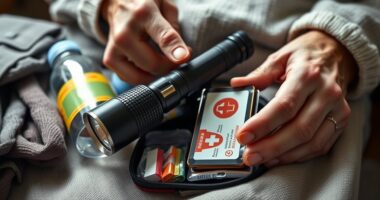To prepare for emergencies, guarantee your assistive devices are in top shape, fully charged, and easily accessible. Create a clear evacuation plan that includes practicing with your devices and identifying obstacles in your home. Communicate your needs to family, neighbors, and emergency responders, and register with local services for added assistance. Regular drills and safety checks help you stay ready. Continue exploring for detailed steps to build a customized, reliable evacuation strategy that keeps you safe.
Key Takeaways
- Regularly inspect, charge, and maintain assistive devices, storing them in accessible locations for quick evacuation use.
- Develop and rehearse evacuation drills that incorporate assistive device retrieval, operation, and safe transfer procedures.
- Establish clear communication plans with family, neighbors, and emergency responders, including accessible alert systems and medical info.
- Identify environmental obstacles and modify home layouts to facilitate easier navigation and evacuation with mobility aids.
- Register with local emergency services and leverage community resources dedicated to assisting individuals with limited mobility during emergencies.

Planning for evacuation when mobility is restricted is essential to guarantee everyone’s safety during emergencies. When you or someone you care for relies on assistive devices, it’s important to incorporate them into your evacuation strategy. These devices—such as wheelchairs, walkers, canes, or mobility scooters—are critical for maintaining independence and safety, but they also require careful planning to make sure they’re accessible and functional during an emergency. Make sure your assistive devices are in good condition, fully charged if applicable, and stored in an easily reachable location. Keep spare batteries, chargers, or replacement parts handy, so you’re prepared if something malfunctions. The goal is to prevent delays or obstacles in evacuation, especially when time is of the essence.
Ensure assistive devices are ready, accessible, and in good condition to facilitate quick, safe evacuation during emergencies.
Effective emergency communication plays a key role in these plans. You need a reliable way to alert others about the emergency and coordinate your safe exit. This might involve specialized alert systems, such as vibrating alert devices or visual signals, if hearing or speech impairments are involved. It’s equally important to establish a communication plan with family, neighbors, or emergency services. Share your specific needs, including details about your assistive devices, so responders can assist you efficiently. Keep a list of emergency contacts, medical information, and device specifications in your emergency kit or wallet, making sure you have access to critical information at all times. Ensuring your emergency preparedness includes reliable backup power options can also be crucial if power outages occur during emergencies.
Practice makes perfect, so regularly rehearse your evacuation plan. Walk through the process with family members or caregivers, simulating different scenarios. This helps identify potential obstacles, such as narrow doorways or cluttered hallways, and allows you to find solutions in advance. During drills, verify that your assistive devices are easy to retrieve and operate, and confirm that your emergency communication tools work correctly. If you use a mobility aid, practice transferring from your device to a safe location quickly and safely.
In addition, coordinate with local emergency services and community resources. Many municipalities offer specialized assistance for individuals with limited mobility during evacuations. Register with these services, so they’re aware of your needs and can prioritize your safety. Having a clear, well-practiced plan that includes assistive devices and reliable emergency communication ensures you’re ready to face any emergency confidently. Remember, preparation and proactive planning are your best defenses to guarantee a safe evacuation, no matter the circumstances.
Frequently Asked Questions
How Can I Find Accessible Evacuation Routes in My Community?
You can find accessible evacuation routes in your community by utilizing accessible route mapping tools online or through local emergency management agencies. Stay aware of community resources like disability advocacy groups or city planning offices, which often have updated information on accessible routes. Talk to neighbors or local organizations to learn about familiar safe paths. Regularly review maps and resources so you’re prepared when an emergency arises.
What Emergency Supplies Are Essential for Limited Mobility Individuals?
You need essential emergency supplies like adaptive devices to assist with mobility and guarantee your safety. Keep a supply of necessary medications for medication management, including extra doses in case of delays. Have a portable charger for communication devices, a flashlight with extra batteries, and a whistle for signaling. Pack comfortable, weather-appropriate clothing, and copies of important documents. Being prepared with these supplies helps you stay safe and supported during emergencies.
How Do I Coordinate With Local Emergency Services for Evacuation?
You might think emergency services will just find you, but proactive communication strategies are key. Reach out early, share your needs clearly, and establish a direct line with local responders. Coordinate volunteer support in advance, so they know how to assist efficiently. Keep a list of contacts handy, and regularly update your plan. This way, when chaos strikes, you’re not left waiting—you’re already in good hands.
Are There Government Programs That Assist With Evacuation Planning?
Yes, there are government programs that can help with your evacuation planning. You might qualify for government grants designed to improve safety and mobility, which can cover costs for mobility aids or emergency preparedness supplies. These programs aim to support individuals with limited mobility, ensuring you have the resources and assistance needed during an emergency. Reach out to local agencies or visit government websites to learn about available grants and support services.
How Can Family Members Prepare to Assist During an Evacuation?
To prepare for an evacuation, you should focus on home modifications that make mobility easier, like ramps or grab bars, and guarantee your family members are trained as caregivers. Practice evacuation drills regularly, so everyone knows their roles. Keep emergency supplies accessible, and develop clear communication plans. By doing these, your family will be better equipped to assist during an emergency, ensuring safety and quick response for loved ones with limited mobility.
Conclusion
Now you know the secrets to evacuation planning for limited mobility—it’s not just about steps or ramps, it’s about saving lives, transforming chaos into calm, and turning fear into safety! With every plan you create, you’re building an unstoppable fortress of protection that can outmatch any disaster. So get ready, stay prepared, and remember: your quick action could be the difference between catastrophe and safety—because when it comes to evacuation, every second counts!









